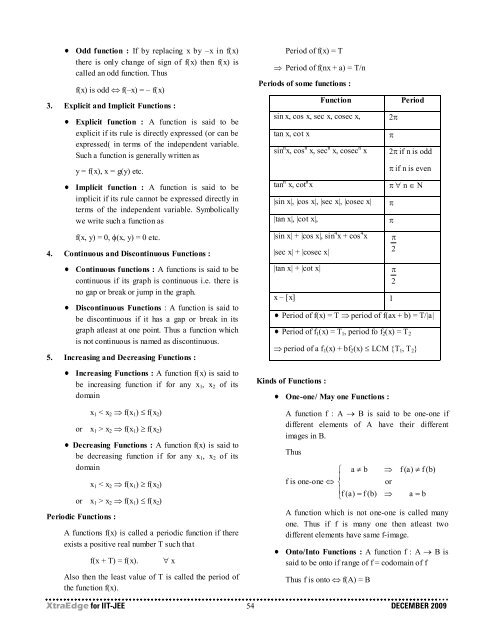Create successful ePaper yourself
Turn your PDF publications into a flip-book with our unique Google optimized e-Paper software.
Odd function : If by replacing x by –x in f(x)<br />
there is only change of sign of f(x) then f(x) is<br />
called an odd function. Thus<br />
f(x) is odd ⇔ f(–x) = – f(x)<br />
3. Explicit and Implicit Functions :<br />
Explicit function : A function is said to be<br />
explicit if its rule is directly expressed (or can be<br />
expressed( in terms of the independent variable.<br />
Such a function is generally written as<br />
y = f(x), x = g(y) etc.<br />
Implicit function : A function is said to be<br />
implicit if its rule cannot be expressed directly in<br />
terms of the independent variable. Symbolically<br />
we write such a function as<br />
f(x, y) = 0, φ(x, y) = 0 etc.<br />
4. Continuous and Discontinuous Functions :<br />
Continuous functions : A functions is said to be<br />
continuous if its graph is continuous i.e. there is<br />
no gap or break or jump in the graph.<br />
Discontinuous Functions : A function is said to<br />
be discontinuous if it has a gap or break in its<br />
graph atleast at one point. Thus a function which<br />
is not continuous is named as discontinuous.<br />
5. Increasing and Decreasing Functions :<br />
Increasing Functions : A function f(x) is said to<br />
be increasing function if for any x 1 , x 2 of its<br />
domain<br />
x 1 < x 2 ⇒ f(x 1 ) ≤ f(x 2 )<br />
or x 1 > x 2 ⇒ f(x 1 ) ≥ f(x 2 )<br />
Decreasing Functions : A function f(x) is said to<br />
be decreasing function if for any x 1 , x 2 of its<br />
domain<br />
x 1 < x 2 ⇒ f(x 1 ) ≥ f(x 2 )<br />
or x 1 > x 2 ⇒ f(x 1 ) ≤ f(x 2 )<br />
Periodic Functions :<br />
A functions f(x) is called a periodic function if there<br />
exists a positive real number T such that<br />
f(x + T) = f(x).<br />
∀ x<br />
Also then the least value of T is called the period of<br />
the function f(x).<br />
Period of f(x) = T<br />
⇒ Period of f(nx + a) = T/n<br />
Periods of some functions :<br />
Function<br />
sin x, cos x, sec x, cosec x,<br />
tan x, cot x<br />
sin n x, cos n x, sec n x, cosec n x<br />
tan n x, cot n x<br />
|sin x|, |cos x|, |sec x|, |cosec x|<br />
|tan x|, |cot x|,<br />
2π<br />
|sin x| + |cos x|, sin 4 x + cos 4 x π<br />
|sec x| + |cosec x| 2<br />
|tan x| + |cot x|<br />
x – [x] 1<br />
π<br />
Period<br />
2π if n is odd<br />
π if n is even<br />
π ∀ n ∈ N<br />
π<br />
π<br />
π<br />
2<br />
Period of f(x) = T ⇒ period of f(ax + b) = T/|a|<br />
Period of f 1 (x) = T 1 , period fo f 2 (x) = T 2<br />
⇒ period of a f 1 (x) + bf 2 (x) ≤ LCM {T 1 , T 2 }<br />
Kinds of Functions :<br />
One-one/ May one Functions :<br />
A function f : A → B is said to be one-one if<br />
different elements of A have their different<br />
images in B.<br />
Thus<br />
⎧ a ≠ b<br />
⎪<br />
f is one-one ⇔ ⎨<br />
⎪<br />
⎩f<br />
(a) = f (b)<br />
⇒<br />
or<br />
⇒<br />
f (a)<br />
≠ f (b)<br />
a = b<br />
A function which is not one-one is called many<br />
one. Thus if f is many one then atleast two<br />
different elements have same f-image.<br />
Onto/Into Functions : A function f : A → B is<br />
said to be onto if range of f = codomain of f<br />
Thus f is onto ⇔ f(A) = B<br />
XtraEdge for <strong>IIT</strong>-<strong>JEE</strong> 54 DECEMBER 2009

















